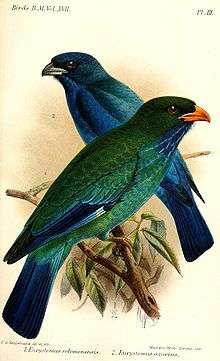Dollarbird
| Dollarbird | |
|---|---|
| | |
| Adult | |
| Scientific classification | |
| Kingdom: | Animalia |
| Phylum: | Chordata |
| Class: | Aves |
| Order: | Coraciiformes |
| Family: | Coraciidae |
| Genus: | Eurystomus |
| Species: | E. orientalis |
| Binomial name | |
| Eurystomus orientalis Linnaeus, 1766 | |
 | |
| Distribution of the dollarbird | |
| Synonyms | |
| |
The dollarbird (Eurystomus orientalis), also known as the Oriental dollarbird or dollar roller, is a bird of the roller family, so named because of the distinctive blue coin-shaped spots on its wings. It can be found in south-west Pacific and east Asia from northern Australia to the Japan archipelago and India.
Description
It has a length of up to 30 cm. It is basically dark brown but this is heavily washed with a bluish-green sheen on the back and wing coverts. Its belly and undertail coverts are light coloured, and it has glossy bright blue colouring on its throat and undertail. Its flight feathers are a darker blue. Its bill is short and wide and in mature animals is coloured orange-red with a black tip. It has very light blue patches on the outer parts of its wings which are highly visible in flight and for which it is named. The females are slightly duller than the males but the two are overall very similar. Immature birds are much duller than the adults and do not have the blue colouring on their throats. They also have brown bills and feet instead of the red of the adults.[2]
Range and habits
It is most commonly seen as a single bird with a distinctive upright silhouette on a bare branch high in a tree, from which it hawks for insects, returning to the same perch after a few seconds.
The birds breed in northern and eastern Australia between the months of September and March or April. The birds prefer open wooded areas with hollow-bearing trees to build nests in. They spend winters in New Guinea and nearby islands.[3]


Various views and plumages
_at_Jayanti%2C_Duars%2C_West_Bengal_W_Picture_060.jpg)
_at_Jayanti%2C_Duars%2C_West_Bengal_W_Picture_059.jpg)
 Singing at Miami MetroZoo, USA
Singing at Miami MetroZoo, USA
References
- ↑ BirdLife International (2012). "Eurystomus orientalis". IUCN Red List of Threatened Species. Version 2013.2. International Union for Conservation of Nature. Retrieved 26 November 2013.
- ↑ http://www.birdsinbackyards.net/species/Eurystomus-orientalis
- ↑ http://www.birdsinbackyards.net/species/Eurystomus-orientalis
Further reading
- Higgins, Peter J., ed. (1999). "Eurystomus orientalis Dollarbird" (PDF). Handbook of Australian, New Zealand and Antarctic Birds. Volume 4: Parrots to dollarbird. Melbourne: Oxford University Press. pp. 1225–1239. ISBN 978-0-19-553071-1.
External links
![]() Media related to Eurystomus orientalis at Wikimedia Commons
Media related to Eurystomus orientalis at Wikimedia Commons
- BirdLife Species Factsheet
- Photos of dollarbirds
- Sound of burung Tiong Batu, Recording AV#13711. Malaysia: Sabah; Sepilok, Rainforest Discovery Centre (within 1km) (5.879, 117.946), recorded by Frank R. Lambert
